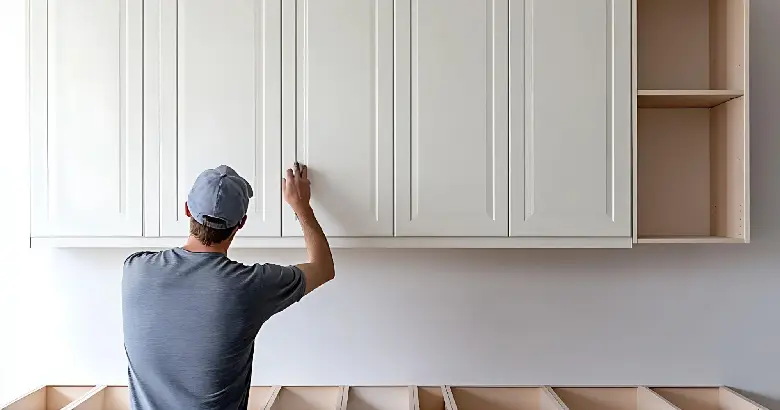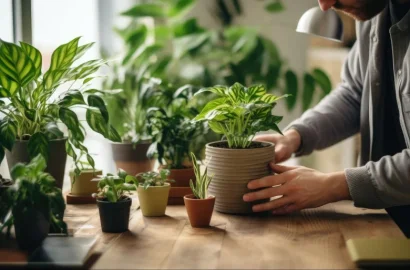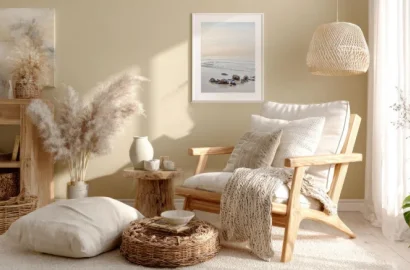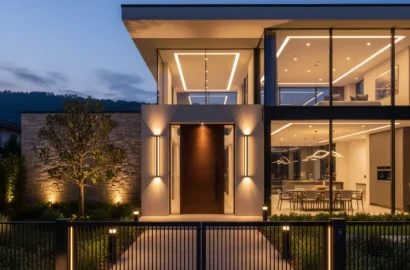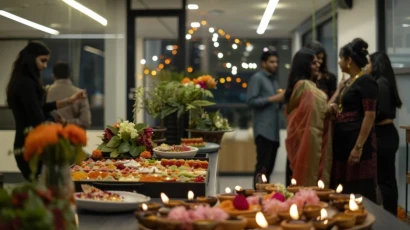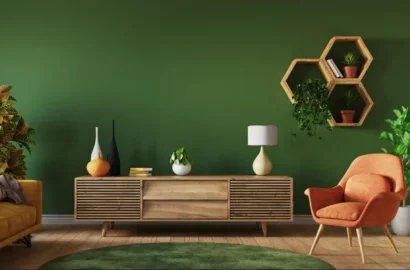What are the three major things to know about Kitchen Cabinet Design? Read on to know the answer and much more.
The internet has many guides and articles on kitchen cabinet design with some showing images of over 50 styles and cabinet design ideas. However, for someone who is planning to design their dream kitchen, looking at multiple ideas that stimulate thought in almost all directions of design styles can get overwhelming at times. Thoughts like “Oh, this one has vintage polished wooden cabinets, looks good ya”, or, “Should I go for a minimalist finish?”, or, “What size cabinet would be good for my kitchen”, or, “Should I go for drawers instead?” become common exclamations that lead to ambiguity.
These are real and important questions that need answering in the context of designing well-functioning and aesthetic cabinetry. In this comprehensive guide, we have explained the very fundamental concepts that are crucial to the understanding of cabinet design.
Here is a list of topics that we discuss in this article!
- Understanding Kitchen Cabinet Design
- Placement of Kitchen Cabinets
- Functioning of the Cabinets
- Aesthetic Options for Kitchen Cabinets
- Kitchen Cabinet Design Types
- Common Mistakes to Avoid in Kitchen Cabinet Design
- Examples of Kitchen Cabinet Designs
- 2025 Kitchen Cabinet Design Trends
- Conclusion
- FAQs
Understanding Kitchen Cabinet Design
There are three things fundamental to the understanding of a kitchen cabinet based on where it is, what all it can store, and how it looks –placement, function, and aesthetic.
Placement refers to the position of the cabinets with respect to other objects like appliances, sink, and counters in the kitchen –are the cabinets positioned above the counter, or placed in a corner to make room for the oven, for instance?
Function refers to how they open and close –do they slide, or are they step-out drawers, or soft-closing ones? It also has to do with how much storage capacity the cabinet comes with.
Aesthetics refers to material and color – are the cabinet doors metallic or wooden, or do they have a matte or a glossy finish?
These factors affect the design choices at the beginning of the process and also determine the final look of the cabinets. Varying amounts of influence of these factors on different spaces can result in different cabinet design styles. Let’s understand these fundamentals in a bit more detail now.
Placement of Kitchen Cabinets
There are two major factors affecting the placement of kitchen cabinets: the layout of the kitchen, and the types of items that need to be stored in those cabinets. Both these factors are practical in nature and also contribute to the visual and overall cohesion of the kitchen space, since cabinets are a primary part of the overall kitchen design.
1. Layout Of The Kitchen
The kitchen layout works as the basic blueprint on which the cabinets are mapped out. Each layout is different from the other- they have their proportions, strengths, and needs—and cabinet design has to respond to that anatomy.
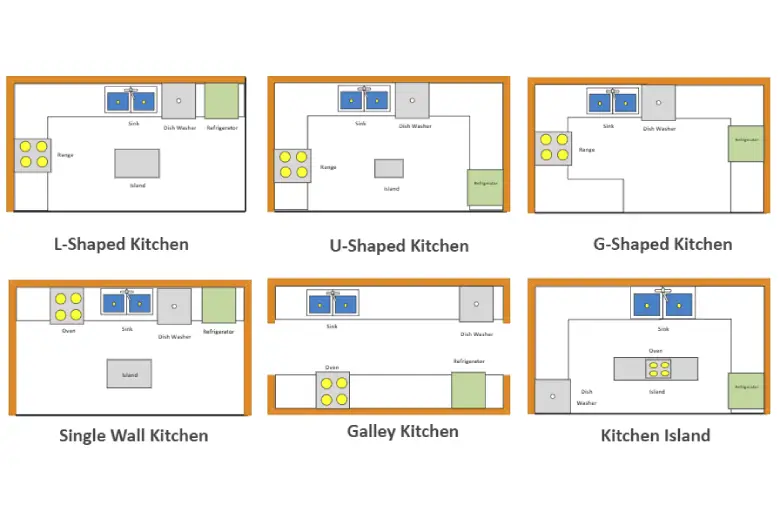
In an L-shaped kitchen, cabinets are arranged along two adjoining walls, forming an ‘L’ that opens up the rest of the space for movement. This layout divides the space in two, cooking on one arm of the L and prep on the other, hence the storage solutions have to be built around them. The corner where the two arms meet becomes a design challenge usually solved using custom storage units like carousels or pull-out drawers.
In a single-wall kitchen, all appliances, cabinets, and countertops are arranged in one straight line. This is common in studio apartments or small homes. Since these spaces have almost no width and only height, tall pantry units and full-height cabinets are installed to store everything vertically.
In an island kitchen, the layout becomes more dynamic, and there is room to experiment. Base cabinets under the island can be useful for storing larger items—pressure cookers, big pots, mixing bowls—that can clutter the main workspace. Some islands even have built-in ovens or sinks, meaning the cabinets around them have to accommodate plumbing or electric lines.
The galley kitchen, in contrast, is long and narrow, with cabinets arranged on two parallel walls like the interior of a ship’s galle-, hence the name. This layout is efficient because everything is within arm’s reach, but it also comes with challenges. Cabinet depth and handle type must be chosen wisely because two bulky base cabinets facing each other can create a cramped feeling and hinder workflow.
2. Items to be Stored
What goes inside the cabinet largely decides the kind of cabinet is needed and where it should go. For daily-use utensils like plates, cups, or lunch boxes, overhead cabinets closer to the sink make sense. For heavier items like woks, mixer grinders, or pots, base cabinets with pull-out drawers are more suitable. Crockery that is not used frequently might be better off in a closed tall unit or a display cabinet. When cabinets are placed with such item-specific considerations, seamless workflow materializes.
Functioning of the Cabinets
Once the cabinets have been installed considering the layout of the kitchen and their primary purpose, the next task is to think about their function i.e. how well they fit in the workflow. Functionality depends on several factors: how easily the drawers open and close, how silent the hinges are, how accessible the contents are, and whether they help or hinder movement through the space.
1. Access and Motion Mechanisms
The way cabinets open, close, and move is central to their usability. Whether it’s a swinging door, a sliding drawer, or a lifting flap, these mechanisms decide how easy it is to get what you need, when you need it.
Hinged Doors
This is the most traditional mechanism wherein a door swings open on one side with the help of metallic hinges fixed along one vertical edge. It’s simple and easy to install. But its biggest limitation is that it needs space in front to open fully. In small kitchens, a swinging hinged door can become an obstacle, especially if multiple cabinets are being accessed at the same time.
Soft-Close Drawers and Doors
Soft-close technology is more of an enhancement than a mechanism in itself, but it has changed how kitchens are experienced. You push, and instead of slamming shut, the cabinet glides back. This might seem like a minor luxury, but in kitchens that accommodate multiple workstations where drawers are opened and shut repeatedly, it reduces long-term damage.
Push-to-Open
Instead of pulling on a handle, you push gently on the cabinet door or drawer, and it opens with a click. It’s sleek and minimalistic; commonly found in simple kitchen cabinet designs where uninterrupted surfaces are part of the design language. It’s also practical for situations when your hands are full.
Slide-Out
Slide-out mechanisms are most often used in lower cabinets, especially in narrow spaces where it would be hard to reach items at the back. Instead of opening a door and reaching in, the entire unit pulls out like a drawer, so the hidden items are visible and reachable, without requiring you to bend or fumble.
Lift-Up (Flap-Up) Doors
The lift-up mechanism opens the cabinet door upward rather than outward. This solves a simple but important problem of a cabinet swinging outward at eye level becoming a hazard. These doors are often supported by hydraulic arms that hold them in place once opened, and close softly when pulled down.
Bi-Fold and Parallel Lift Systems
A more advanced version of the lift-up door, the bi-fold mechanism involves a door that folds in half as it rises upward. These are helpful for wider cabinets where a single large flap might be too heavy to lift. The parallel lift system lifts the door up and forward in a single motion like a car trunk, and is the luxury version of the folding system for overhead cabinets above appliances or sinks.
Pocket Doors
Pocket doors are a modern kitchen cabinet design. These doors open outward and then slide into a slot within the cabinet frame, away from sight. This is useful in tall pantries or appliance cabinets, where you might want to keep the door open while working but out of the way.
Cabinet mechanisms that open and close properly, as well as drawers and doors that function without obstruction or noise, help maintain an efficient kitchen workflow.
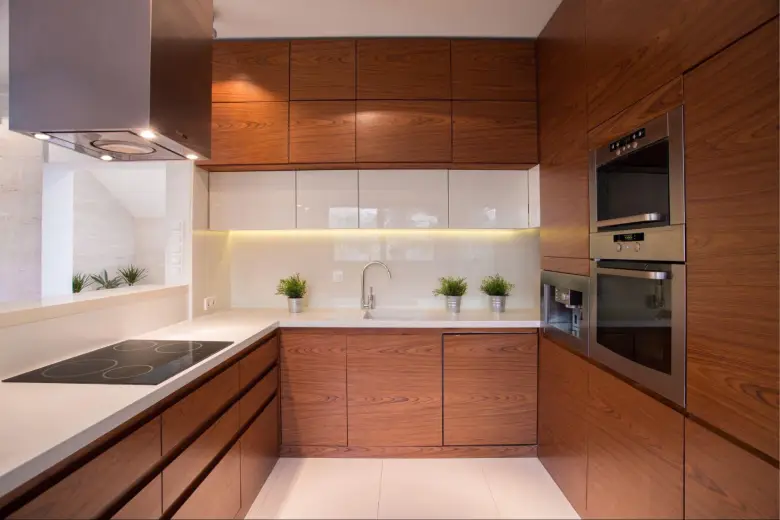
Aesthetics of the Cabinets
Every cabinet has a physical structure- be it wood or metal, handles or push mechanisms, situated on the floor or mounted on a wall. But beyond this physicality based on the previous two tenets, there is also personality and storytelling; after all, it is about design. This can be done through aesthetic choices- color, material, and hardware. These choices are also reflected in trending styles such as kitchen cabinet glass design, aluminum kitchen cabinet design, and wooden kitchen cabinet designs.
1. Material and Texture
The material of a cabinet plays towards durability and the foundational design style. Wood, for instance, signals tradition and warmth. Natural wood grains in teak, oak, walnut, and sal create a vintage look. Laminate can mimic other materials or surface graphic patterns. There is stainless steel, often associated with commercial kitchens, which bring in a more utilitarian aesthetic. Glossy finishes reflect light that can make a small kitchen look larger. Matte finishes absorb light, and offer a sophisticated feel. Different materials and textures have various effects on the viewer, so the material choice must be based on the desired effect and overall feel of the space.
2. Color and Tone
Colors don’t work in isolation, they interact with flooring, wall finishes, countertop material, and the natural light of the space. Neutral colors like white, beige, and grey are often chosen for their ability to visually expand a space. A deep navy blue or forest green cabinet can signal richness. Bright yellows and reds may excite, and charcoal or stone tones might make the space feel calm. Modern kitchens, although, are seeing more experiments, such as two-tone cabinets, pastel shades, or black-on-black combinations.
3. Hardware and Detailing
Hardware is considered an accessory but has an influence on the cabinet’s aesthetic. The shape of a handle, the knob, or even the lack thereof (as in handleless cabinets) signals design intent. Brass or golden hardware can add warmth and vintage appeal. Sleek chrome or nickel can contrast with a minimalist, modern space. Leather or matte black handles create specific moods, industrial, rustic, or edgy, without changing the cabinet body itself. In contemporary modular kitchens, these details are often designed to fade into the background, while in custom kitchens, they are celebrated as marks of craftsmanship.
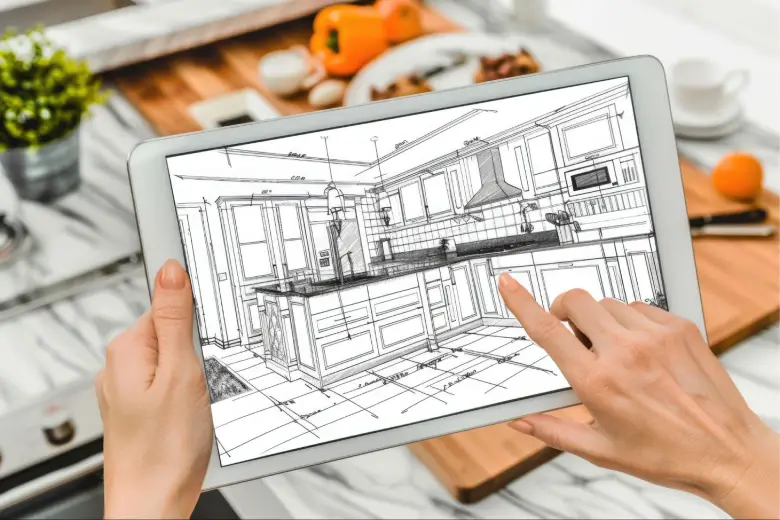
Kitchen Cabinet Design Types
The design of the cabinet is perhaps the most directly visible aesthetic decision. It’s the face of the cabinet, literally, and plays a huge role in defining the kitchen’s style. There are many design types for cabinets, based on door types and overall structure, some of which we have explored below.
1. Shaker Cabinet Doors
One of the most widely recognized cabinet door styles is the Shaker door. Its design is simple, a five-piece construction with a flat center panel surrounded by a rectangular frame. The style originates from the Shaker religious community of 18th-century America, who believed in utility, clarity, and honesty. In modern kitchens, Shaker doors feel modern when painted in whites or greys, or warm and rustic when finished with natural wood stains.
2. Slab Doors
A cabinet door that embodies pure minimalism. Constructed from a single, flat sheet of material without any frame, or embellishments. It’s the style that goes with sleek countertops, handleless drawers, and push-to-open systems. Because there are no crevices or grooves, slab doors are low maintenance. It is a favorite in modern and ultra-modern kitchens.
3. Raised Panel Doors
These doors feature a center panel that is elevated above the surrounding frame, accompanied by decorative bevels along the edges. This design gives the door a sculpted quality. The style has roots in classic furniture-making traditions, and commonly finished in woods or creamy paints, it remains a staple in kitchens aiming for a formal feel.
4. Glass-Front Cabinet Doors
Glass-front cabinet doors bring lightness and openness to kitchen spaces. In this style, a wooden or metal frame holds a panel of clear, frosted, or textured glass in the center. Glass doors display crockery and decorative items. For homeowners who prefer a bit more privacy, frosted glass versions offer an opaque view that hides clutter and keeps the lightness of the design. Kitchen cabinet glass design is popular for adding a feeling of luxury.
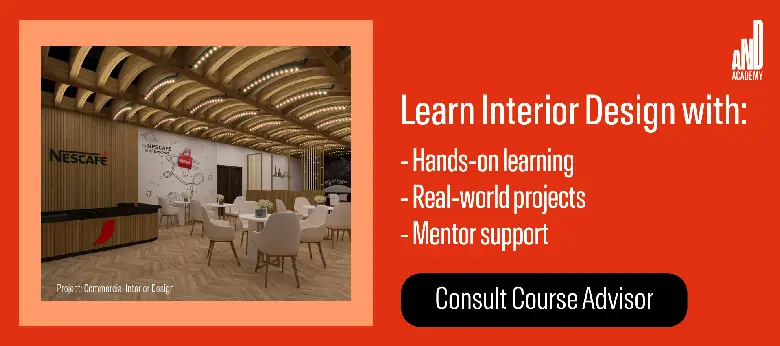
5. Louvered Cabinet Doors
Louvered doors stand out for their unique design. Made up of horizontal wooden slats with gaps between them, resemble window shutters which are meant for air to circulate through the cabinet. The word "louver" comes from the French l’ouvert, meaning “the open,”. These doors are especially useful for spaces that require ventilation, such as cabinets storing food staples like onions or potatoes, or those housing appliances that generate heat, like microwaves.
6. Beadboard Cabinet Doors
Beadboard cabinet doors consist of a center panel made from narrow vertical planks or the appearance of such planks created through detailing. The style takes inspiration from traditional beadboard paneling, commonly used in early American homes and still popular in cottage, country, and farmhouse interiors. They are a good choice for those wanting to bring a rustic vibe into their kitchen. The only caveat is maintenance; the grooves between the planks trap dust and need attention when cleaning.
7. Inset Cabinet Doors
Inset doors, unlike overlay doors that rest atop the cabinet frame, are fitted within the frame itself, sitting flush when closed. This method requires expert craftsmanship, as the margins must be exact to allow the door to open and shut smoothly. The visual result is a seamless, furniture-like look that signals craftsmanship and premium. Inset cabinetry does come with higher costs due to the installation required.
8. Framed and Frameless Cabinets
Cabinet construction type refers to the way the cabinet box is built. Framed cabinets have a face frame attached to the front of the box offering extra strength and a traditional look. It also makes installing doors easier. Frameless cabinets skip the face frame altogether. Popular in European and modern kitchens, they offer more storage space and a clean, minimalist appearance and, because there's no frame in the way, access to the interior is increased.
9. Partial Overlay Cabinets
In partial overlay cabinetry, the doors only partially cover the face frame of the cabinet. Gaps between doors and the frame underneath are visible. This style was once the industry standard and is still widely used in traditional kitchens. They give the kitchen a classic and layered look and are also easy to repair and replace.
10. Full Overlay Cabinets
Full overlay cabinets take a polished approach. In this design, doors and drawer fronts completely cover the cabinet’s face frame, for a sleek, almost flat surface. The gaps between doors are minimal, which means more storage. It’s a popular option in modern and transitional kitchens, where clean lines and utility are prime. The look feels custom and aligns with handleless or hidden systems. Full overlay cabinets cost more than partial overlay because of the extra materials and precision involved.
11. Glazed Finish Cabinets
A glazed finish adds a false shadow. It’s a technique where a semi-transparent glaze is applied over painted cabinets to highlight detailing and corners by creating soft shadows that add depth. The glaze can be clear or tinted, depending on whether you want to darken the edges or add contrast respectively. It’s commonly used with raised panels or beadboard doors, as the glaze accentuates the curves and bevels. Glazed cabinets bring an artisanal feel to the kitchen.
12. Stained Finish Cabinets
Stained cabinets or polished cabinets make the wood shine. Rather than coating the surface in opaque paint, the stain penetrates the gaps between the wood grain, adding character. Different types of stains—water-based, oil-based, or natural—create different effects, sheens, contrast, etc. Staining is especially favored for traditional and/or rustic kitchens, where natural materials are used.
13. Catalyzed Varnish Cabinets
Catalyzed varnish, sometimes called conversion varnish, is a clear coat that gives cabinets a tough, protective layer. Unlike regular finishes, this is chemically cured using an acid catalyst, which hardens quickly and adds durability. It doesn’t change the cabinet’s base color but adds a sheen. This finish resists moisture, stains, and wear.
14. Polyurethane Varnish Cabinets
Polyurethane varnish is one of the most common protective finishes for kitchen cabinets. It forms a hard, transparent coating that resists water, heat, and daily wear and tear. Its available in matte, satin, semi-gloss, and high-gloss versions, depending on the level of shine desired. This varnish is a practical choice for busy kitchens because it’s easy to clean. It works over natural wood or stained cabinets to preserve their look.
15. Laminate Cabinets
Laminate cabinets are a popular choice in Indian kitchens, for their toughness and range of design options. Made by pressing decorative sheets onto plywood or engineered wood, laminates are highly resistant to moisture, heat, and scratches. They come in hundreds of textures— glossy to woodgrains to digital prints. They’re easy to clean and budget-friendly. However, the edges can peel over time if not sealed well.
16. Veneer Cabinets
Thin slices of real wood are adhered (glued) to a plywood core, giving the look of solid wood at a fraction of the cost. Veneers preserve natural grain patterns and color variations of the wood they are sliced from. Unlike laminates, which are printed, veneers are actual wood—so they age and patina(wood becoming darker by losing moisture over time) like solid hardwoods. They’re often finished with stains or varnishes to enhance and protect the surface.
Examples Explaining How Cabinet Designs Fit Different Kitchen Styles
Cabinets don’t exist in isolation—they’re part of a larger kitchen story. The style of the kitchen determines the type of cabinets that functionally and aesthetically fit the space. Below are a few examples that show how different kitchen designs influence the choice of cabinet materials and finishes.
Modern Minimalist Kitchen

The above example is that of a modern contemporary kitchen which is of the island variety, which means that there is room for large cabinets to be installed. It features a matte finish on the wooden cabinet doors, and plain white on the countertop for contrast, which is minimalist. The storage here is designed to hide clutter and maintain a sleek look.
Modern Simple Kitchen
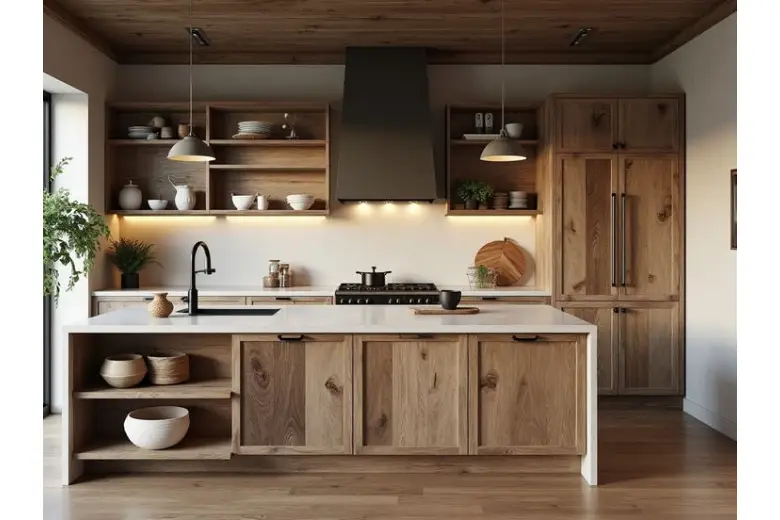
Here is an example of a modern simple kitchen design. It features the Shaker-style cabinet doors which, by having been left unpolished, adds a rustic vibe to the space. The open shelving design makes the space seem larger than it is and the LED light strip adds a warm feeling to the space.
Modular Kitchen Design
Here is an example of a modular-style kitchen that features an island in the middle of the space, which means there is space for larger cabinets to maximize space usage. If you look closely near the bottom of the wooden cabinets that feature elegant metal handles and knobs, you’ll see that they are identical. That is, they are part of the same layout and can be rearranged in the desired layout.
Common Mistakes to Avoid in Kitchen Cabinet Design
While designing a space, it is easy to get caught up in the excitement of choosing the color, texture, and aesthetics of the cabinets. However, it is important to be mindful of the practicality and functionality of the design, so that regrets can be avoided down the line. Here are some mistakes that one should avoid during the kitchen cabinet design process.
1. Lower Drawers and Not Cabinets
Many people regret not opting for drawers instead of cabinets for the lower cabinets. Drawers are more accessible than door-style cabinets since they pull out and make all their content visible, you do not have to bend and fish around for stuff at the back. The only exception here is the kitchen sink, which stores piping underneath it, and drawers would make them inaccessible.
2. Extended Handles That Stick Out
In small kitchens, it is not uncommon for clothing or aprons to get stuck in the extended portion of the TT-shaped handle. You wouldn’t want your sweat pockets or pants to catch on to these extended handles and cause a bruise.
3. Doors That Don’t Fully Open
Kitchens must be efficient and ensure workflow; doors that don’t fully open or bang into appliances or another set of doors defeat their main purpose. This usually happens in corner cabinets or galley layouts where maneuverability is limited.
These mistakes can be ironed out in the planning phase while defining how the kitchen will be used.
2025 Kitchen Cabinet Design Trends
The world of design is constantly evolving and so are the modular kitchen cabinet design trends. Here are some of the design trends that are catching the hype in the cabinet design department.
1. European Handles
The European details are popping back up in designer kitchens. Exposed hinges, vintage-themed brass handles, and knobs are gaining an appreciation for their charm and heritage-adding quality.
2. Shaker Style Cabinets but with Thinner Borders
This is the effort towards a certain kind of minimalist look that is also traditional in some sense. It is much in line with the current zeitgeist of phenomena being this and that as opposed to this or that. The classic shaker style will now start to appear more contemporary.
3. The Cafe Style Kitchen
Coffee stations are becoming increasingly popular in modern kitchens, and so the cabinets around them have to make space, and as a solution, open shelving is being preferred.
4. Hiding Appliances Using Pocket Doors
There is a growing demand for inconspicuously organized kitchens, that hide appliances, either by using sliding doors that conceal into a wall or, a garage-style door for the toaster and coffee station.
Final Thoughts
Designing kitchen cabinets involves balancing placement, aesthetics, and functionality, in the overall space. Be it modern handle-less designs, rustic wooden cabinets, or modular units, the three simple tenets should help guide your design choices toward creating the perfect kitchen cabinet. Happy Designing!
FAQs
Q. Are handleless cabinets practical?
- Yes, their streamlined design is stylish and makes cleaning much simpler.
Q. How can I make a small kitchen look bigger?
- Go for light-colored finishes, and glass-front cabinets, and maximize vertical storage space.
Q. What are the best cabinet layout options for small space kitchen cabinet design?
- The most effective layouts for small-space kitchen cabinet design include galley, L-shaped, or single-wall setups.
Q. Can I use open shelving in a small space kitchen cabinet design without making the kitchen look cluttered?
- Yes, open shelving can work well in small space kitchen cabinet designs if used sparingly and styled with care. Keeping shelves minimal and color-coordinated.
Next Steps
If you intend to seek further practical guidance in the process of designing your kitchen space, we recommend taking a look at these projects:
- Residential Interior Design Project by AND learner Anusha Somasundaram
- Residential Interior Design Project by AND learner Sonali Khajuria
For more insights into the latest trends and apps for the interior design industry, please head over to the AND Academy Blog. In case you need further assistance, here are some resources to consider:
- Watch this session by Snehanshu Mukherjee, Founding Partner at T.E.A.M and Mansi Almadi, an Interior Designer at Studio Lotus
- Talk to a course advisor to discuss how you can transform your career with one of our courses.
- Check out our Interior Design courses - all courses are taught through live, interactive classes by industry experts.
- Take advantage of our scholarship and funding options to overcome any financial hurdle on the path of your career transformation.
Note: All information and/or data from external sources is believed to be accurate as of the date of publication.

